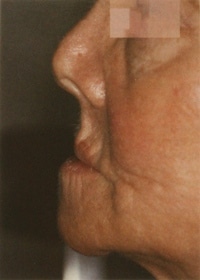
Facial Collapse and How to Fix It
Facial collapse is a condition that affects the facial structure of a person. It is caused by the deterioration of the bones and tissues that make up the face, leading to a sunken and hollowed-out appearance. Various factors, including age, genetics, smoking, poor nutrition, and trauma, can cause this condition.
It can also be caused by tooth loss, which can cause the facial muscles to become weak and unable to support the facial structure. Facial collapse can cause a person to look much older than they are, leading to difficulty speaking and eating. In addition, it can cause psychological distress due to the change in appearance. Fortunately, there are treatments available to help restore the facial structure and reduce the signs of facial collapse. These treatments include facial implants, bone grafts, and dermal fillers.
After your teeth are all extracted, the jaws begin to shrink. Your body now considers the bone in the jaws useless, taking those minerals elsewhere. Over ten or twenty years, you will end up with a condition called Facial Collapse.
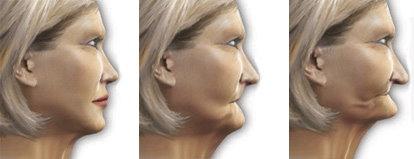
As you may or may not know, your mouth, gums, teeth, and jaw bones affect many of the body’s systems, including the immune, nutrition, and circulatory systems. Gum disease is particularly damaging and is linked to heart disease, immune deficiency, dangerous inflammation, low birth weights, and a symbiotic relationship with diabetes. Improper occlusion – how your upper and lower teeth meet in biting and chewing – can impede nutrition by limiting diet or cause incomplete chewing, which is the vital first step in digestion. Poor occlusion can cause pain in sleep apnea and TMJ or jaw joint.
Photos on this page courtesy of Dr. Carl E. Misch are from his textbook, Dental Implant Prosthetics, which is the world’s most widely read dental implant textbook.
If You’re Missing All Your Teeth
Contents [show]
When you’re missing all your teeth, the only way to restore most of your mouth function is with dental implants. In the past, removable full dentures were considered an adequate solution because it was the best we could do. The problems with removable dentures are:
- They can’t restore even 25 percent of your eating efficiency.
- They move around in your mouth, often creating sore spots and difficulty eating and speaking.
- When your teeth are missing, your body senses that and begins to absorb the minerals in the bone for use elsewhere in the body. This results in a condition called facial collapse.
- Loss of confidence.
Here is an illustration of facial collapse. Notice how the entire lower face is shorter, from the nose to the chin. Notice also how the lips are sunken, and facial lines are accentuated.
After several years, people who have lost all their teeth will become dental cripples – unable to eat, self-conscious, and unable to retain a conventional denture because their jaws have shrunk and there is nothing for the denture to rest on.
The good news is that there are several options for restoring your mouth. We have a page listing the dental implant options – you may want to consult that page. Here is a brief list of those options for people who have lost all of their teeth:
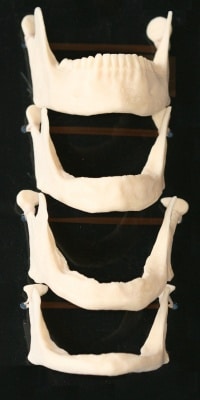 Teeth in a day
Teeth in a day- Snap-on denture
- Fixed implant/denture hybrid
- Removable bridge
- Fully fixed implant restoration
Here are a series of models of the lower jaw, showing the progression of bone loss that will occur over the years. The top model shows all the teeth present. Each succeeding model shows more and more bone loss.
Many patients who have had no teeth for maybe twenty years have a jawbone that looks like the lowest model and finds themselves uncomfortable and unable to function because there is no bone left to support a conventional denture.
Consider this. Many of you reading this will live well into your 80s or beyond. Do you want to be able to eat normally at that age? Or do you want to be like many of those at that age who keep their teeth in a drawer, which are limited to soft foods, and who have gastric or other health problems because of that? Do you want your long-term quality of life issues to be decided by an insurance company whose primary concern is cutting costs? We will help you no matter how you decide on these issues, but we have seen too much misery not to want to bring these long-term consequences to your attention.
Dental Implant Surgery
If you are presently in a situation where you have little or no bone left, we can still help you. Comfort and function can be restored with implant surgery. View photographs of our implant success stories to see for yourself.
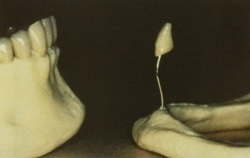 On the right is a photograph of two actual lower jawbones, one with all the teeth present and another that has had the teeth missing for an extended period. A false tooth is propped on a wire to illustrate how much bone the body has reabsorbed.
On the right is a photograph of two actual lower jawbones, one with all the teeth present and another that has had the teeth missing for an extended period. A false tooth is propped on a wire to illustrate how much bone the body has reabsorbed.
A person with a lower jaw similar to the photograph above on the left would be a dental cripple, unable to wear a conventional denture. This is the sad reality faced by too many patients.
 A periodontist, however, restores many of these cases to complete functionality.
A periodontist, however, restores many of these cases to complete functionality.
Unfortunately, the wearing of dentures unsupported by dental implants accelerates bone loss. On the left is a diagram of the facial changes after wearing conventional dentures for years.
Solutions for cases of facial collapse
- Bone grafting – We can build up the lost bony structure to restore jaw function.
- Denture/Implant Hybrid restoration replaces lost bone and gum tissue with dental restorative materials.
- Precise computerized placement of implants – When the bony foundation is lacking, the prospects of getting a solid, long-lasting result are enhanced by carefully placing the implants in whatever solid areas of bone remain. These solid areas are identified with careful radiographic diagnosis and advanced implant placement techniques. Similar techniques are used in the teeth-in-an-hour protocol and with the NobelGuide™ system.
When dental implants are present, they stimulate the bone and keep it from atrophy. This is called the piezoelectric effect, and you may read more about it by clicking this link. The greater the number of dental implants placed, the greater the piezoelectric effect and the better the protection against facial collapse.
Below are two photographs of patients with facial collapse. Notice the sunken-in upper lip, the shriveled face, and the shortened nose-to-chin distance. Not only would these people look younger, but they would also feel better and eat better if their mouths were restored correctly.
The Piezoelectric effect
When teeth or dental implants are present in the jaw, a stimulus is sent to the bone that keeps it from dissolving. This is called the piezoelectric effect, one of the most important reasons for restoring missing teeth with dental implants rather than some other method. It is essential for people who miss all their teeth because they will eventually suffer facial collapse if implants are not placed.
The Piezoelectric effect has also been studied for dental treatments. Applying a small electrical charge to a tooth makes it possible to stimulate the growth of new bone and soft tissue, which can be used to repair damage caused by cavities or periodontal disease. This technique is also non-invasive and can reduce the time needed for a dental procedure.
If you’re missing all your teeth, placing eight dental implants in each jaw is enough to preserve your bone nicely. If that doesn’t fit your budget, the more dental implants you can have placed, the better.
The x-ray below illustrates this effect dramatically. The patient here, a 68-year-old female, has no teeth left. Fifteen years ago, dental implants were placed in her lower front. Now, after fifteen years, there is practically no bone left in her upper or most of her lower arch. But there is a lot of bone in the lower front, where implants have kept the bone stimulated and from atrophy.
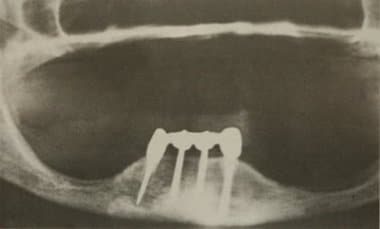
We don’t want to minimize the seriousness of the bone she has lost in the rest of her mouth because she is at risk of jaw fracture and other problems, but we only want to point out that where the implants are located, the bone atrophy has been prevented. She would have been best off having had four more implants in her lower posterior and eight in her upper jaw.
Conclusion
Facial collapse is a condition that occurs when the bones in the face lose their structure and density due to the loss of teeth. This can lead to a sunken appearance and an aged look. Facial collapse can be caused by various factors, including tooth decay, gum disease, and even trauma. The good news is that facial collapse can be reversed with the help of dental implants. Dental implants are artificial teeth surgically placed into the jawbone, providing a stable foundation for replacement teeth. The implants replace the missing teeth, providing support to the facial bones and preventing further collapse. Additionally, dental implants can improve the aesthetics of the face, restoring the natural contours of the face and creating a more youthful appearance. With the help of dental implants, patients can restore their facial structure and improve their overall appearance.

